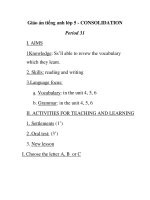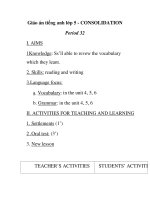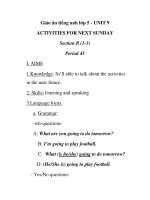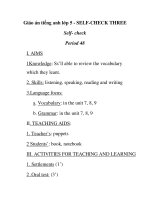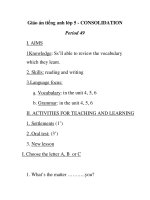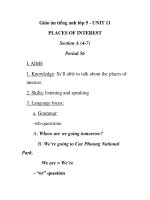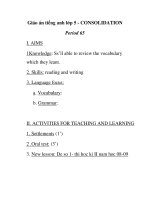- Trang chủ >>
- Mầm non - Tiểu học >>
- Lớp 5
Giáo án tiếng anh lớp 5 BGD cv 2345 week 2
Bạn đang xem bản rút gọn của tài liệu. Xem và tải ngay bản đầy đủ của tài liệu tại đây (74.15 KB, 8 trang )
Week: 2
Period: 5
UNIT 1: WHAT’S YOUR ADDRESS?
Lesson 3 (1-2-3)
I. Objectives.
By the end of the lesson, students will be able to:
1. Knowledge:
- Pronounce two-syllable words with the stress on the first syllable: 'city, 'village,
'mountains, 'tower.
- Listen and circle the letters showing the correct words filling the gapped sentences.
- Say the chant Where do you live?
- Sentence Patterns: Revision
- Vocabulary: Revision
2. Skills:
- Listening and speaking.
3. Attitude/ Quality:
- Be confident in communicating with friends/ teachers.
- Show pride and love to your hometown and respects to other’s hometown.
4. Forming competence:
- Co-operation (Ready to help friends in pair work/ groupwork).
- Self-study ( can perform individual tasks and solve problems by themselves).
- Use language to talk about what a village/ town/ city is like, do the listening task and
read the chant.
II. Methods:
- Communicative approach, group Ss and T's activities, play as a character, teaching
methods with game, teaching methods by visual, teaching methods by practising,
discussion group, technical present....
III. Preparation.
1. Teacher’s preparation: CDs player, stereo, book.
2. Student’s preparation: Students’ aids: books, notebooks, workbooks.
IV. Procedures
Content
Teacher’s activities
Student’s activities
A. Warm up
- Have the class to play game: Slap the - Play game
(5’)
board, using the phrases learnt in the
previous lessons.
- Lead into new lesson
B. New lesson 1. Listen and repeat. (10 minutes)
(30’)
- Tell the class that they are going to
- Listen to the T's
practice saying two-syllable words with instruction.
the stress on the first syllable.
- Put the words on the board with the
stress marks and say them a few times.
- Play the recording for pupils to listen
- Listen and repeat
and repeat.
- Ask pupils to read the words and
- Read individual
sentences until pupils feel confident.
- Get some pupils to say the words and
sentences in front of the class.
- Correct mistakes of pronunciation.
2. Listen and circle a or b. Then say the
sentences aloud. (10 minutes)
- Tell pupils that they are going to listen
and circle a or b to complete the
sentences.
- Give them a few seconds to read the
sentences in silence and guess the
words to fill the gaps.
- Play the recording twice for pupils to
listen, circle a or b.
- Play the recording again for pupils to
listen and check. Ask some pupils to
read the sentences aloud.
- Give the correct answers.
* Key: 1 b
2a
3a
3. Let’s chant (10 minutes)
- Tell pupils that they are going to say
the chant: Where do you live?
- Play the recording all the way through
for pupils to listen and follow in their
books.
- Play the recording again, pausing after
each line for pupils to repeat.
- Play the recording once more for
pupils to repeat the whole chant, show
pupils how to chant and do the actions
- Get pupils to work in pairs to practice
chanting and doing the action.
-Invite some pairs to say the chant and
do actions in front of the class
- Give feedback.
- Ask the whole class to say the chant
and clap along to the rhythm of the
chant.
C. Production Summary the lesson.
(3’)
D. Homework - Tell pupils to practice chanting again
(2’)
at home.
- Listen and comment
- Listen to the T's
instruction.
- Read and guess
- Listen and circle.
- Listen and check, then
read the sentences aloud.
- Listen to the T's
instruction.
- Listen and follow in
the book
- Listen and repeat
- Listen, repeat and do
the actions
- Chant in pairs
- Chant in front of class
- Say and clap along to
the rhythm of the chant
- Listen and remember.
- Take note
********************************************************************
Week: 2
Period: 6
UNIT 1: WHAT’S YOUR ADDRESS?
Lesson 3 (4-5-6)
I. Objectives.
By the end of the lesson, students will be able to:
1. Knowledge:
- Pronounce correctly the stress of the two syllable nouns
- Read the paragraph, and tick the sentences Y (Y) or N (No).
- Write about their friends, using the guiding questions.
- Draw a house, write its address, and present the drawing to the class.
- Colour the stars showing their English competences.
2. Skills: Listening, reading, writing and speaking.
3. Attitude/ Quality:
- Be confident in communicating with friends/ teachers.
- Love people and their hometown.
4. Forming competence:
- Co-operation (Ready to help friends in pair work/ groupwork).
- Self-study ( can perform individual tasks and solve problems by themselves).
- Use language to talk about what a village/ town/ city is like, do the listening task and
read the chant.
II. Methods:
- Communicative approach, group Ss and T's activities, play as a character, teaching
methods with game, teaching methods by visual, teaching methods by practising,
discussion group, technical present....
III. Preparation.
1. Teacher’s preparation: CDs player, stereo, book.
2. Student’s preparation: Students’ aids: books, notebooks, workbooks.
IV. Procedures
Content
Teacher’s activities
Student’s activities
A. Warm up
(5’)
B. New lesson
(30’)
- Have the class say the chant: Where
do you live?
- Lead into new lesson
4. Read and tick Yes or No. (10’)
- Tell pupils that they are going to read
the texts and tick Yes or No.
- Give a few seconds for pupils to read
the sentences and underline the key
words/ phrases in silence.
- Ask pupils to read the text again and
do the task
- Set a time limit for pupils to do the
task.
- Go around the class and offer help, if
necessary.
- Have pupils exchange the answers
with their partners
- Call four pupils to write their answers
on the board.
- Give feedback and correct mistakes
* Key: 1 N 2 Y 3N
4Y 5Y
- Chant
- Listen to the T's
instruction.
- Read in silence
- Do the task
- Works in pairs
- Write on the board.
5. Write about your friends. (10’)
- Tell pupils that they are going to write
about one of their friends.
- Give pupils time to read the questions
and write the answers in their
notebooks.
- Go around offering help, if necessary.
- Ask pupils to write their answers on
the board.
- Give feedback.
Key:
6. Project (10 minutes)
- Tell pupils that they are going to do a
drawing project.
- Give pupils time to work in groups to
discuss the house they are going to
draw, and its address.
- Invite a few groups to present their
drawings to the class and talk about
them.
- Give feedback
7. Colour the stars.
- Have the class read the statements and
check their comprehension
- Give the time to colour the star and
invite a few pupils to read the statement
aloud
- Give further support to pupils who
find it difficult to achieve certain
objectives.
C. Production - Summary the lesson
(3’)
D. Homework - Tell pupils to do exercises in
(2’)
workbook.
- Listen to the T's
instruction.
- Do the task
- Write the answers.
- Listen to the T's
instruction.
- Practice in pairs
- Present in front of
class.
- Colour the stars.
- Listen and remember
- Take note
*********************************************************************
Week: 2
Period: 7
UNIT 2: I ALWAYS GET UP EARLY. HOW ABOUT YOU?
Lesson 1 (1-2-3)
I. Objectives:
By the end of the lesson, Ss will be able to:
1. Knowledge:
- Ask and answer questions about someone’s daily routine
- Sentence Patterns: What do you do _____?
I always / usually / often / sometimes _____.
- Vocabulary: always brush my teeth, usually do morning exercise, often cook dinner,
sometimes watch TV
2. Skills:
- Speaking skill
3. Attitude/ Quality:
- Be confident in communicating with friends/ teachers.
- Should have good habits.
- Love themselves.
4. Forming competence:
- Co-operation (ready to help friends in pair work/ groupwork).
- Self-study (can perform individual tasks and solve problems by themselves).
- Use language to talk about daily routine.
II. Methods: Communicative approach, group Ss and T's activities, play as a
character, teaching methods with game, teaching methods by visual, teaching methods
by practising, discussion group, technical present....
III. Preparation.
1. Teacher’s preparation: CDs player, stereo, book.
2. Student’s preparation: Students’ aids: books, notebooks, workbooks.
IV. Procedures
Content
Teacher’s activities
Student’s activities
A. Warm up
(5’)
B. New lesson
(30’)
- Get pupils to sing the song: The wheel
on the bus.
- Lead into new lesson
1. Look, listen and repeat. (10‘)
- Ask pupils to look at the picture to
point at each character and elicit their
answers to the questions:
Who’s this? What’s he doing? Who’s he
talking with online? What does he do in
the morning? What does he do after
school/in the afternoon?
- Play the recording for pupils to listen
to the tape
- Play the recording again and ask them
to repeat a few times.
- Explain new words: address, tower.
- Say aloud the words, then ask pupils to
repeat the words a few times
- Have pupils write down the new words
into their notebook
- Ask pupils to practice in pairs to
practice the dialogue.
- Go round and check pupils can repeat
and understand the dialogue.
- Check some pairs. Ask other pupils to
give comments.
- Give comments.
- Sing the song
- Look at the pictures
and give the answers
- Listen carefully
- Listen and repeat
- Repeat the words.
- Write down
- Work in pairs.
- Practice in front of
class. Others gives
comments
2. Point and say. (20 minutes)
- Tell the class that they are going to
practice asking and answering questions
about someone’s daily routines, using:
* Structure:
What do you do in the
morning/afternoon/evening?
I always/usually/often/ sometimes ...
- Introduce new words: brush my teeth),
often, do morning exercise, cook dinner,
sometimes, never.
- Say aloud for pupils to repeat it.
- Ask pupils to write down the new
words and the structure in their
notebook.
- Have pupils practice asking and
answering in pairs.
- Call some pairs to practice in front of
the class
- Give feedback and correct mistakes of
pronunciation.
3. Let’s talk
- Tell the class that they are going to
practice further by asking and answering
questions about someone’s daily
routines.
- Get pupils time to work in pairs to ask
and answer, using the structure.
- Invite a few pairs to act out their
C. Production conversations in front of the class.
(3’)
- Give feedback summary the lesson
- Tell pupils to read the part 1 again.
D. Homework - Do exercises in work book, learn by
(2’)
heart the new words and the structure.
- Listen to the T's
instruction.
- Repeat.
- Write down.
- Work in pairs
- Practice in front of the
class
- Listen to the T's
instruction.
- Practice in pairs
- Act out in front of
class
- Listen and remember
- Take note.
*********************************************************************
Week : 2
Period: 8
UNIT 2: I ALWAYS GET UP EARLY. HOW ABOUT YOU?
Lesson 1 (4-5-6)
I. Objectives:
By the end of the lesson, Ss will be able to:
1. Knowledge:
- Ask and answer questions about someone’s daily routine
- Listen and tick the correct pictures.
- Read and complete the gapped paragraph with the words provided.
- Sing the song This is the way we do things.
- Sentence Patterns: Revision
- Vocabulary: The song lyrics
2. Skills:
- Speaking, listening and reading skill
3. Attitude/ Quality:
- Be confident in communicating with friends/ teachers.
- Should have good habits.
- Love themselves.
4. Forming competence:
- Co-operation (ready to help friends in pair work/ groupwork).
- Self-study (can perform individual tasks and solve problems by themselves).
- Use language to talk about daily routine.
II. Methods: Communicative approach, group Ss and T's activities, play as a
character, teaching methods with game, teaching methods by visual, teaching methods
by practising, discussion group, technical present....
III. Preparation.
1. Teacher’s preparation: CDs player, stereo, book.
2. Student’s preparation: Students’ aids: books, notebooks, workbooks.
IV. Procedures
Content
Teacher’s activities
Students’ activities
A. Warm up - Invite three pupils to act out the story in - Act out in front of class.
(5’)
activity 1.
- Ask and answer.
- Call two pairs of pupils to ask and
answer questions about their daily
routines, using:
What do you do in the morning/
afternoon/ evening? I always/ usually/
often/ sometimes ...
- Listen to the T's
- Lead into new lesson.
B. New
instruction.
4. Listen and tick. (10 minutes)
lesson
- Tell pupils that they are going to listen
(30’)
- Look at the pictures
to the recording and tick the correct
pictures.
- Listen and tick.
- Ask pupils to look at the pictures to
identify the characters and their activities.
- Give the answers.
- Play the recording the second time for
- Listen and check
pupils to listen and tick the pictures.
- Ask pupils to give answers
- Play the recording again for pupils to
listen and check
- Give correct answers.
- Listen to the T's
Key: 1 c 2 b 3 b
4a
instruction.
5. Read and complete. (10 minutes)
- Tell pupils that they are going to read
- Read
and fill the gaps with like, do, TV, play
and usually.
- Give time for pupils to read the text and
the words in the box. Tell them to focus
on the context to select the appropriate
words from the box.
- Ask pupils to do the task independently.
- Go around and offer help, if necessary.
- Ask pupils to give answers and other
pupils to give comments.
- Give correct answers.
*Key: 1 do 2 usually 3 play
4 TV 5 like
6. Let’s sing (10 minutes)
- Tell pupils that they are going to sing
the This is the way we do things song.
- Get pupils to read the lyrics in silence.
Check their comprehension.
- Play the recording all the way through
for pupils to get familiarized with the
pronunciation, the stress, the rhythm and
the intonation of the song.
- Play the recording again, pausing after
each line for pupils to repeat.
- Play the recording once more for pupils
to repeat the whole song.
- Then have them practice in groups.
- Call on some groups to sing the song in
front of the class. The rest of the class
clap their hands at rhythms.
- Summary the lesson
C. Production - Tell pupils to do exercises in work book
(3’)
- Ask pupils to practice singing at home
D. Homework
(2’)
- Do the task
- Give answers and other
pupils give comments.
- Listen to the T's
instruction.
- Read
- Listen and repeat.
- Listen and repeat once
more.
- Work in groups
- Sing and clap the hands
at rhythms.
- Listen and remember.
-Take note
*********************************************************************

